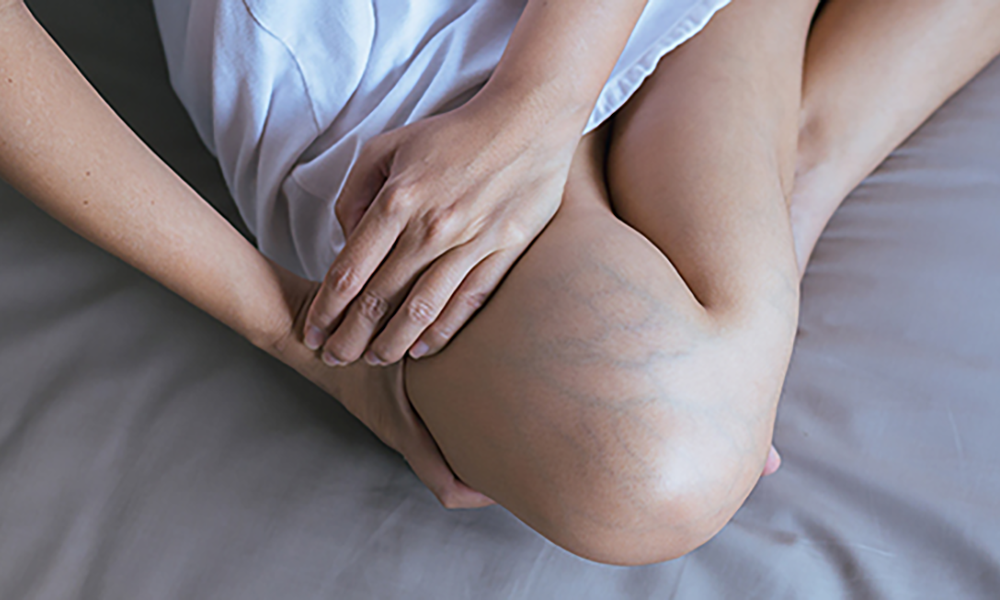 Vein disease is a common occurrence. It is relatively easy to treat and, when managed with careful treatment, it is usually not a life-threatening condition.
Vein disease is a common occurrence. It is relatively easy to treat and, when managed with careful treatment, it is usually not a life-threatening condition.
With proper treatment, your quality of life can easily be restored. Without proper medical care, however, vein diseases can become life-threatening, which is why treatment is so important.
Venous diseases show up in two ways: clotting and blockages (thrombosis) and improper blood return (insufficiency). In a normal circulatory system, veins bring oxygen-depleted blood back to the lungs for reoxygenation. When vein diseases occur, it becomes more challenging to get oxygen back into the blood system as a whole.
Vein diseases must be recognized and treated in a timely manner to prevent deeper issues from developing. Here are the types of vein diseases and the warning signs for each.
TYPE #1: Thrombosis: Superficial Thrombophlebitis
A blood clot can lie deep within limb tissue or it can be more superficial, appearing just under the skin. These shallow blood clots are known as superficial thrombophlebitis and they usually show up as a red streak. They can be accompanied by swelling and tenderness and may even be warm to the touch. The vein might also darken or harden,
This type of thrombosis usually happens in varicose veins, and may be caused by cancer and its underlying malignancy; this is known as Trousseau’s Syndrome. It usually occurs in the legs, but can sometimes show up in a person’s arms or neck as well.
In most cases, superficial thrombophlebitis is usually more of an annoyance than an imminent danger; this kind of blood clot does not pose as much of a risk to break off and travel to the lungs. It’s easily treatable from home by elevating the affected area, moist heat, and non-steroidal anti-inflammatory medicines like Advil. Persistent clots may require a short course of blood thinners.
Type #2: Thrombosis: Deep Vein Thrombosis
Blood clots farther under the surface, deep within the tissue are known as deep vein thrombosis or DVT. These are harder to diagnose, as symptoms only present themselves in 50% of patients. You may experience leg pain and swelling as well as leg pressure or fullness and, in some cases, even warmth, redness, and tenderness.
These type of clots pose much more of a threat, as they are more likely to cause an embolism by traveling to the lungs. In fact, without treatment, 1 in 4 DVT clots that are left untreated will detach, travel through the veins, and lodge themselves in the lungs, causing a pulmonary embolism, a life-threatening event, resulting in shortness of breath, limitations on physical exertion, and even death.
You might be at risk for DVT if you are stationary for a long period of time, like for a prolonged bedrest or recovery time after a surgery or as a result of paralysis. You can also inherit a blood clotting disorder that can result in DVT.
Other causes include pregnancy, use of birth control pills or hormone replacement therapy, being overweight, smoking, some forms of cancers, heart failure, a family history, or sitting for long periods of time - like at a desk or on a long flight. Also, being over the age of 60 increases your risk of DVT.
Type #3: Venous Insufficiency: Varicose Veins
Varicose veins occur just below the surface and are dilated, snake-like parts of the veins that appear swollen, because there is a backflow of blood pooling in that section of vein. Similarly, valves may become insufficient, allowing blood to settle, creating the same pooling sensation.
Symptoms of varicose veins may just be cosmetic, although some may experience burning, aching, and itchiness. Legs may also feel stiff or sore and may worsen throughout the day. Symptoms may not be as bad in the morning after a night of elevating the legs, but they can worsen with standing. Left untreated, varicose veins can lead to skin ulcers and infections, blood clots and bleeding.
Women tend to experience varicose veins more than men, but men are certainly not immune to its effects either. Varicose vein side effects can be lessened with exercise, and with weight loss and control of blood pressure. Compression stockings are also helpful in reducing symptoms and further complications, and leg elevation can also help. Cosmetic procedures such as the injection of scarring agents may also help, but this type of procedure does not commonly have lasting effects.
Type #4: Venous Insufficiency: Chronic Venous Insufficiency
If inadequate venous drainage happens for an extended period of time, for example, as a result of DVT, it can be considered chronic venous insufficiency. It can be a result of faulty valves and unobstructed blood flow. Other causes may be from inherited abnormalities, or restricted blood flow, like from bandaging, or even a tumor.
Chronic venous insufficiency can show up in the form of darkening of the skin and leg swelling, as well as a coarsening of the texture of the skin. There can also be leg pain, and sensations of limb heaviness. Gravity is helpful in reducing symptoms, as is the use of compression stockings: anything to improve the blood return to the heart. Occasionally, diuretics are also used to treat chronic venous insufficiency in extreme cases.
If you are experiencing discomfort or pain as a result of vein disease, please call the Johnson Memorial Wound and Vascular Care Center at 317.346.2700 today.
